Too Transparent?
Responding to new energy goals with facade design
![]() Continuing Education
Continuing Education
Use the following learning objectives to focus your study while reading this month’s Continuing Education article.
Learning Objectives - After reading this article, you will be able to:
- Explain why energy codes are leading architects to rethink the use of all-glass facades.
- Identify design features that warrant consideration in response to new energy codes and occupant demands for improved comfort.
- Discuss how high-performance glazing, shading, dynamic glass, fabric membranes, double-skin facades, and building integrated photovoltaics are helping to support expansive glass facades.
- Assess, through case studies, successful applications of these technologies in achieving energy savings and increased user choice and comfort.
While the beautiful aesthetic created by large expanses of facade glazing is not disappearing any time soon, increasingly stringent energy codes are pushing architects to seriously reconsider just how much glass they can afford.
“The dominant drivers, at least with large commercial and luxury residential buildings, continue to be aesthetic,” confirms Mic Patterson, LEED AP BD C, vice president of strategic development for the Advanced Technology Studio of Enclos in Los Angeles, California. “Building developers want floor-to-ceiling glass because of market demand, despite the negative effect on thermal, solar, and acoustical performance.”
However, an initiative called the Architecture 2030 challenge is pushing all new buildings, developments, and major renovations to be carbon-neutral by the year 2030, and the Energy Independence and Security Act of 2007 is directing projects built after 2025 toward a zero-net-energy goal. While these targets are still a few years away, they are beginning to shape the all-glass facade.

Photo courtesy of Connie Zhou Photography/Gensler
Described as the greenest high-rise in the country, Pittsburgh’s Tower at PNC Plaza successfully merges an expansive glass facade with highly energy-efficient technologies.
Furthermore, ASHRAE Standard 90.1 and California’s Title-24 are already making an impact now, guiding nonresidential buildings to limit window area to 40 percent or less of the total wall area, while requiring high-performance glazing that balances thermal performance with high visual light transmittance for daylighting, according to Erik Ring, P.E., LEED Fellow, principal of LPA Inc. in Irvine, California.
“Currently there is a ‘perfect storm’ forming, as energy codes, environmental mandates, and economic drivers are all coming together,” states Udi Paret, general manager building solutions, Solaria Corporation, San Francisco, California. “From international agreements, such as the COP21 (Conference of Parties) Sustainable Innovation Forum, to federal incentives, such as the extension of the higher solar investment tax credit bracket, all the way to municipal level code requirements, such as last year’s update to Title 24 for at least 1 percent renewable energy generation in new construction, there’s a myriad of drivers making developers and building owners realize that innovative designs in glass facades are necessary to maintain competitive edge and the value of their properties.”
So, in order to overcome the modeled energy penalty associated with the poor-performing, all-glass envelope, designers are more seriously evaluating technologies such as high-performance, insulated low-e glazings, electrochromic and photochromic glass, solar shading, double-wall facades, and, to some extent, building-integrated photovoltaics (BIPV).
That said, it’s important to point out that the codes that more directly address window-to-wall ratios only do so from a prescriptive-design approach, still leaving room for designers to well exceed the recommended 40 percent ratio, as long as they can ratchet down energy consumption in other ways, i.e. a performance-based approach to meeting code.
“The newer, stricter codes are certainly making a drive toward a more energy-efficient building. As a result, it pushes us as architects to rethink the traditional ‘glass box.’ This inherently encourages the use of less glass in the facades and a greater use of high-performance glazing and high-performance mechanical systems, but doesn’t mandate anything,” explains Laura P. Beene, AIA, LEED AP BD C, project designer/project manager for Earl Swensson Associates (ESa) in Nashville, Tennessee.
While Omar Renteria, AIA, NCARB, LEED AP BD C, senior project director for EYP Architecture & Engineering in New York, acknowledges that more frequent code publishing cycles are driving improvements in overall best practices, they still don’t support the high-performance baselines that today’s envelopes require. Instead, “they take into consideration average metrics that are very broad and are more geared to baselines as static points in time from an environmental perspective, and therefore don’t always address the trend toward more unpredictable and rapidly changing environments to which envelopes must adapt to in order to truly meet sustainability goals.”
In other words, buildings can’t be viewed as isolated elements within the built environment, he says, and more effective results will need to come from designers performing more extensive analysis and energy modeling to achieve high-performance metric targets.
For example, while glass is certainly needed for daylighting and views, for other envelope areas—such as at interstitial spaces that don’t have transparent or translucent requirements—Renteria says that too much emphasis is placed on glass when a different and potentially more sustainable material would be better suited to achieve a more efficient response. “In short, designers could be more responsible from a sustainable point of view to use glass where it is needed, but look for other material solutions where it is not.”
THE NEED FOR GLASS
To the extent that the building codes are pushing higher energy standards, there is still a strong desire amongst owners, architects, and users for large amounts of natural light inside their buildings.
“Many architects and owners do still seek highly glazed building designs,” states Ring. “Fully glazed buildings can provide striking exterior elevations and dramatic first impressions on the interior.”
“Glass is critical and fundamental in the design of any building,” agrees Beene. “Glass shapes our spaces, can act as a defining design element, the natural light it creates shapes our moods, and the view provides a connection to the outside world beyond. These needs don’t go away just because we need to be more energy efficient, but it does challenge us as designers to question the amount of glass we use and balance the desire versus the need for glass.”
In terms of sorting through the technological solutions that can be employed to support a more expansive glass aesthetic, the first line of defense is usually high-performance glazing, for example, glass with a low U-factor and high solar heat gain shading coefficient, tinted and reflective glass, and triple-glazed insulated glass units.
Glass films, either laminated to the glass panes or suspended in between, have also become more available recently and significantly contribute to glass performance, adds Thomas Chinnock, AIA, an associate of Shepley Bulfinch in Phoenix, Arizona.
The Cleveland-based market research firm, The Freedonia Group, forecasts that U.S. demand for high-performance flat glass products will increase 8.2 percent annually through 2017.1
Meanwhile, the U.K-based Palmer Market Research group reports that commercial glazing posted a 29 percent rise in volume value growth from 2012 to 2014, and a further 20 percent rise in market value is anticipated out to 2019.2
Fortunately, high-performance glazing has advanced significantly over the past decade, and designers anticipate that new coatings and technologies will continue to emerge and advance, particularly in response to the trend toward energy efficiency. “It’s one of the most economical design tools we have in our toolbox to maintain significant glass exposure but maintain compliance with the energy codes,” remarks Beene.
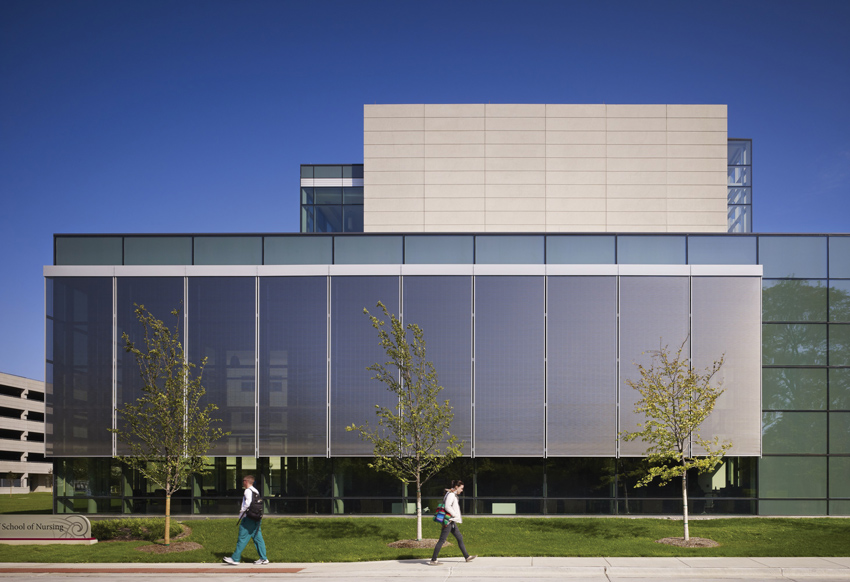
Photo courtesy of Transsolar
At Loyola University’s Marcella Neihoff School of Nursing in Chicago, Illinois, designed by Solomen Cordwell Buenz, automatically controlled solar shades on the west facade and fixed louvers on the south facade are so effective that a thermally activated slab is capable of meeting all the cooling demand in the space.
Capitalizing on triple-silver technology—which applies three layers of silver during the magnetron sputter coating process, thereby delivering a high level of selectivity between light transmission and solar factor—the latest generation of low-e glazings are currently capable of delivering visible light transmittance levels above 50 percent with a solar heat gain coefficient below 0.25, which is a noted improvement in performance.
That said, Patterson offers a cautionary note against specifying an IGU with a low-e coating and calling it a day. “In spite of the significant gains achieved by the glass industry over past decades, especially in the area of solar glazings, even the high-performance glazings remain markedly poor thermal insulators, and solar control remains a problem,” he says.
Suggesting an alternative, Ring recommends unitized curtain wall systems with spandrel panels to present the exterior impression of a fully glazed building, while blocking much of the unnecessary thermal gains. He explains that often the best design choice is thoughtfully locating expansive glazing for the desired daylighting, views, and exterior impact, and using spandrel panels to improve thermal performance for the rest of the facade.
Meanwhile, Ring’s LPA colleague Rick D’Amato, AIA, LEED AP, principal, is witnessing an increase in alternative daylighting strategies, such as controlled skylights and tubular daylighting devices. “When possible, a thoughtful examination of the internal spaces has resulted in a ‘form follows function’ approach to facade design, which places and sizes glazing according to optimal use.”
In terms of solar shading systems, Ring says they can be highly effective in improving the thermal and daylighting performance of building envelopes, with the caveat that they must be designed correctly. The devices also require careful consideration to constructability and maintenance concerns.
Furthermore, their effectiveness is contingent upon climate, building orientation, and the location of the fenestration within the building, i.e. the number of stories and/or the depth of the floor plates. “Shading may provide significant benefit, or little to no benefit at all, depending on the design and location,” says Beene.
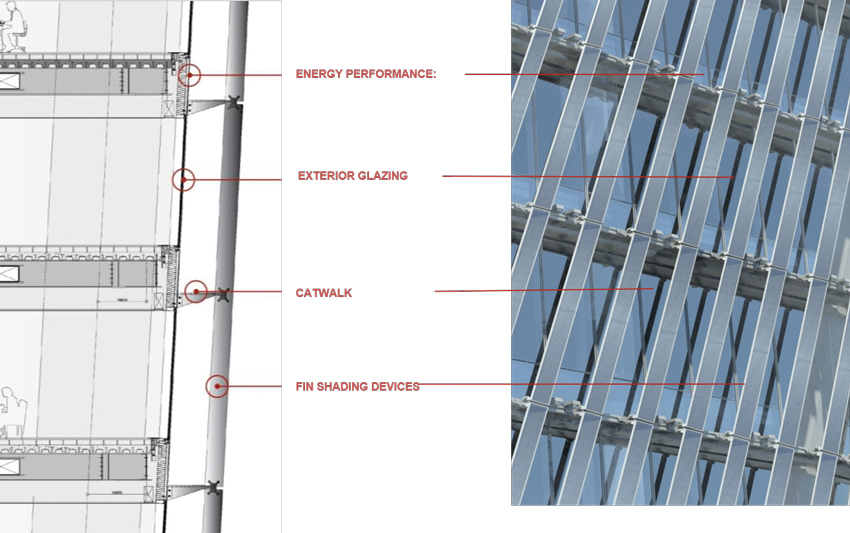
Image courtesy of HOK
At the 80-story Capital Market Authority Tower in Riyadh, Saudi Arabia, HOK specified fin-shading devices in an offset frit pattern, a triple-glazed IGU system, catwalk, and a photovoltaic array.
One of many examples where shades were successfully applied is Loyola University’s Marcella Neihoff School of Nursing in Chicago, Illinois, designed by Solomen Cordwell Buenz. According to Pratik Raval, associate director at Transsolar Inc. in New York, automatically controlled solar shades on the west facade and fixed louvers on the south facade help reduce solar loads to the point that a thermally activated slab can meet all of the cooling demand in the space.
Similarly, a high-profile international project—the HOK-designed Capital Market Authority Tower in Riyadh, Saudi Arabia—incorporates fin-shading devices in an offset frit pattern, along with a triple-glazed IGU system, catwalk, and a photovoltaic array at the top of the building’s 80-story crown. According to Roger Soto, AIA, LEED AP, design principal for HOK’s Gulf Coast region, the fins are optimized both in their plan position and sectional angle to account for the solar tracking, significantly reducing direct solar incidence from the harsh Middle Eastern sun on the conditioned enclosure.
DYNAMIC GLAZING
Growing in popularity, a compelling alternative to the challenges inherent in shading systems is dynamic glazing. In response to a low-voltage application of electricity, a pane of electrochromic glass darkens to one or more predetermined levels and then returns to its clear state once the voltage polarity reverses.
“Dynamic glass is a great option, as it allows for expansive windows, without the need for blinds and shades, because the windows tint on demand,” explains Brandon Tinianov, vice president of business development for dynamic glazing manufacturer View in San Francisco. “By decreasing the heat that is associated with a typical window installation, dynamic glass decreases HVAC costs by about 20 to 25 percent, and in a new build, can influence builders to use a smaller HVAC system from the start.”
Case in point, at the net-zero-energy Marine Corps Air Station City Hall building in Miramar, California, 1,935 square feet of low-performing, clear glass was replaced with dynamic glazing and then measured and verified over a period of 12 months by the U.S. Department of Defense’s Environmental Security Technology Certification Program. Posting impressive findings, the installation achieved close to 30 percent in HVAC savings, more than 60 percent in lighting savings, and a 95 percent satisfaction rate by building occupants.3
On another recent project, Shepley Bulfinch was tasked with finding the best way to reduce light levels for a higher education building atrium. “During the summer months, direct sun in the space made it uncomfortable for students. However, light levels were pleasant on overcast days or during the winter,” says Jonathan Baron, AIA, LEED AP, Boston-based director of Shepley Bulfinch. “Shading was found to be too expensive, and baffles that might block some of the sunlight were found to be too intrusive in the existing space. Finally, tinting the glass to cut summer sun would leave the space gloomy and unpleasant on winter days.”
Ultimately, electrochromic glass proved to be the best solution to this complicated problem. It blocks sunlight from directly entering the space, but still allows indirect sunlight in more favorable locations.
In terms of recent technological advances with dynamic glazing, manufacturers are incorporating sophisticated control algorithms into their systems, which take into account advanced weather inputs to better predict the sun’s movement and incoming weather conditions, such as cloud cover. Fed by real-time information, the dynamic glazing automatically adjusts based upon the current lighting and solar gain levels entering the facade.
Other, newer dynamic glazing options include multiple tint zones within one pane of glass and the ability to specify the product in a variety of geometric shapes, such as triangles, parallelograms, and diamonds.
While the technology is considered to be commercially viable, it is still relatively new to the market and has not yet been widely adopted.
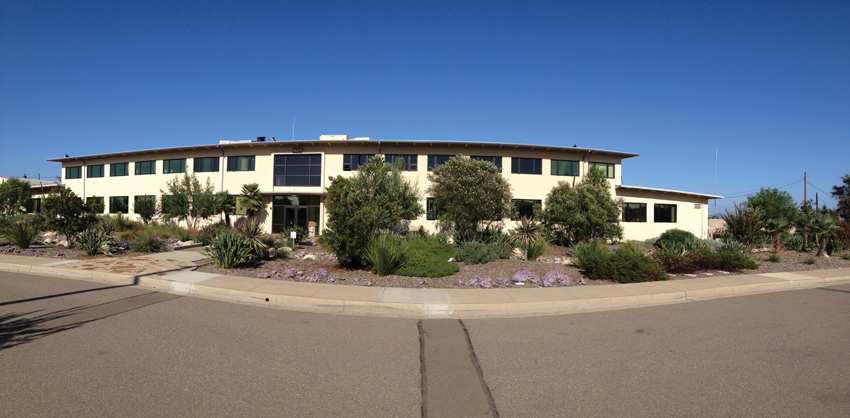
Photo courtesy of The View
Dynamic glazing was independently verified to save 30 percent in HVAC costs, more than 60 percent in lighting expenses, and post a 95 percent satisfaction rate by building occupants at the net-zero-energy Marine Corps Air Station City Hall building in Miramar, California.
BUILDING-INTEGRATED PHOTOVOLTAICS
While still considered a niche market, BIPV is slowly but surely making its way into more building projects, such as Frank Gehry’s Novartis Building in Basel, Switzerland, where facade integrated photovoltaics generate energy, provide effective shading, and bring daylighting into the facility.
Previously hampered by unattractive aesthetics and high cost, newer automated semiconductor mechanical processing technologies—combined with highly durable, high-performing silicon cells—is making the technology more viable.
“The most innovative BIPV technology is now presented to the market as a complete, fully engineered, fabricated solution ready for seamless installation,” reports Solaria’s Paret. “Whether standardized or customized, the process from design to installation across the building skin is simplified, and products are being installed at costs that are comparable to traditional, non-PV systems.”
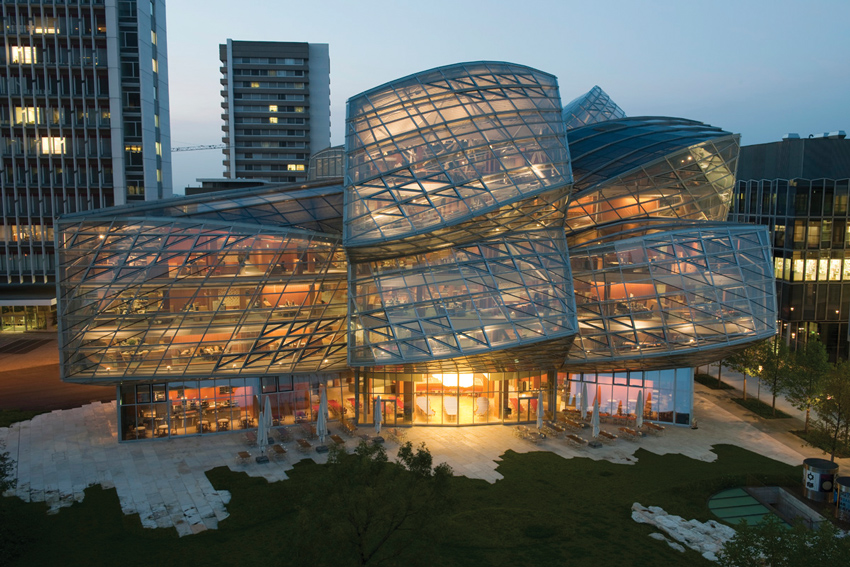
Photo courtesy of The View
Dynamic glazing was independently verified to save 30 percent in HVAC costs, more than 60 percent in lighting expenses, and post a 95 percent satisfaction rate by building occupants at the net-zero-energy Marine Corps Air Station City Hall building in Miramar, California.
In fact, the U.S. General Services Administration’s Green Proving Ground program—designed to take innovative technologies and evaluate them in real-world settings to accelerate the adoption of sustainable building technologies—recently incorporated BIPV into the program. So far, this has involved rigorous U.S. Lawrence Berkeley National Laboratory BIPV testing of energy generation, glass performance, tenant comfort, economics, and the design-build process.
The next step will be considering BIPV amongst GSA’s vast real estate portfolio, starting with a commercial pilot installation at a federal building in Kansas City, where additional data will be collected and compared with non-BIPV windows in the same building, according to Paret.
“More awareness about the real benefits of BIPV is infiltrating influencers not only in architecture, building, and construction, but also across policy makers and thought leaders. Increasingly, it is accepted that BIPV solutions offer a reliable, seamless alternative to traditional glass solutions, while providing additional value in moving glazed facades toward the goal of positive net energy gains,” he adds.
On the flip side, architects point out that for many buildings, vertical elevations with insufficient surface area are not a good fit for BIPV, which is why rooftops and exterior canopies are a more popular choice.
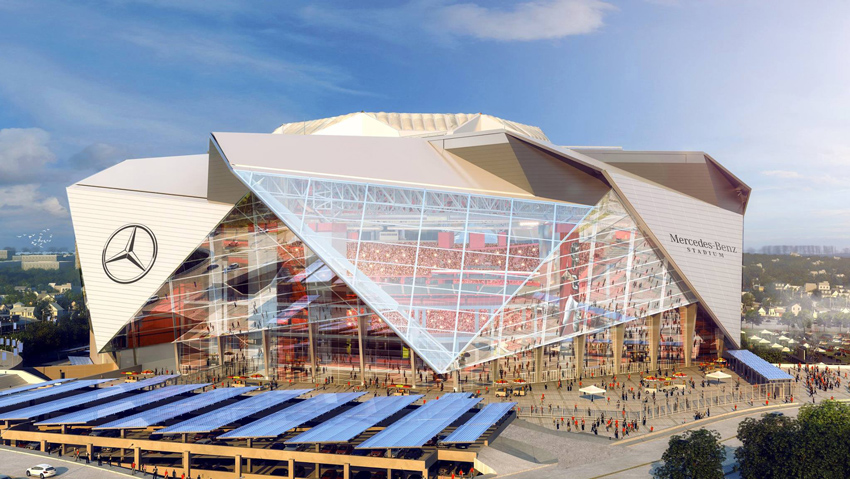
Photo courtesy of Transsolar
Frank Gehry’s Novartis Building in Basel, Switzerland, serves as a successful application of building-integrated photovoltaics.
FABRIC MEMBRANES
Another alternative to glass is architectural fabric membranes, which offer similar performance to insulated glass, with reduced structural requirements.
“Depending on the loading criteria, ethylene tetrafluoroethylene (ETFE) films have the ability to span 5- to 15-foot widths and heights over 100 feet as a single glazing unit,” explains Michael Lair, business development manager for Birdair in Dallas, Texas. “Not only does this reduce the steel required compared to glass curtain walls, but you end up with a much more unrestricted visibility, eliminating the need for horizontal extrusions required to capture the much smaller glass units. Furthermore, the large size of the ETFE glazing units also allow more light transmission.”
Case in point, ETFE film cushions were installed for the retractable roof at the Atlanta Falcon’s Mercedes-Benz Stadium, in addition to approximately 165,000 square feet of a vertical single ETFE skin supported by a cable net system around various areas of the building’s perimeter. The lightweight, transparent membrane allows daylight to flow into the space below, while providing cover.
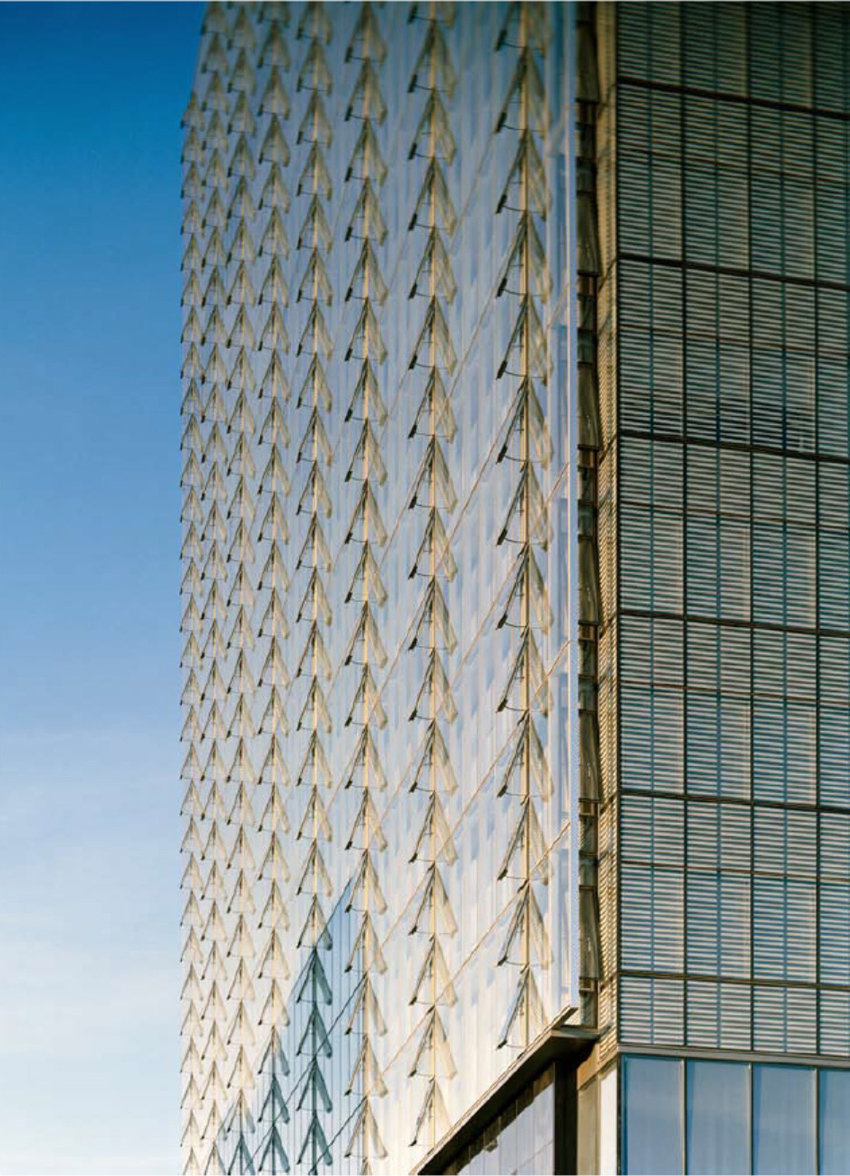
Photo courtesy of Birdair
ETFE film cushions adorn the retractable roof at the Atlanta Falcon’s Mercedes-Benz Stadium, along with a vertical single ETFE skin supported by a cable net system around various areas of the building’s perimeter.
A similar product, Teflon and PVC mesh fabrics can be an effective solar screening facade, particularly for curtain wall and ribbon window systems that aren’t meeting newer glass standards.
“The mesh provides an economical approach to helping reduce solar heat gain in old glazing systems, while giving an unattractive building facade a more modern look, without removing the existing facade,” explains Lair.
DOUBLE-SKIN FACADES
Unlike the technological solutions previously mentioned, double-skin facades are a compelling architectural solution, offering a host of energy-efficient benefits. Made from two layers of glass assemblies, an internal cavity collects solar heat, which is then used to heat the building. At the same time, the exterior and interior facades are opened at key times to bring natural ventilation into the facility.
“The constant air flow in the cavity between the two layers of exterior wall serve as a buffer to the external climate and help minimize the need for larger mechanical systems,” explains Renteria.
At the same time, double facades call for a high level of integrated engineering, require a fully coordinated building management system, are complicated assemblies, and necessitate an intense design and construction process. “The expertise and labor-intensive effort required not only to design but to fabricate, install, and then maintain these envelopes translates into higher costs than owners typically want to incur.”
“I’ve had owners that were very sustainably motivated and had the opportunity to explore double-skin facades, but unfortunately, no opportunity to actually utilize them in a final design,” says Beene. “They end up being very costly and therefore very difficult to justify when other more conventional methods of energy conservation and solar shading are more affordable.”
However, Benedict Tranel, AIA, LEED AP, a principal of Gensler, stresses the importance of factoring user comfort and natural ventilation into the investment, beyond the energy savings, as these variables have implications on the bottom line, such as supporting better occupancy rates.
For example, the double-facade designed by KPMB Architects at Winnipeg’s Manitoba Hydro Place was measured to reduce 1½ sick days per employee per year, in addition to significantly reduced service calls, on account of the extended use of natural ventilation through operable windows providing a sense of user control and connection to the outdoors.
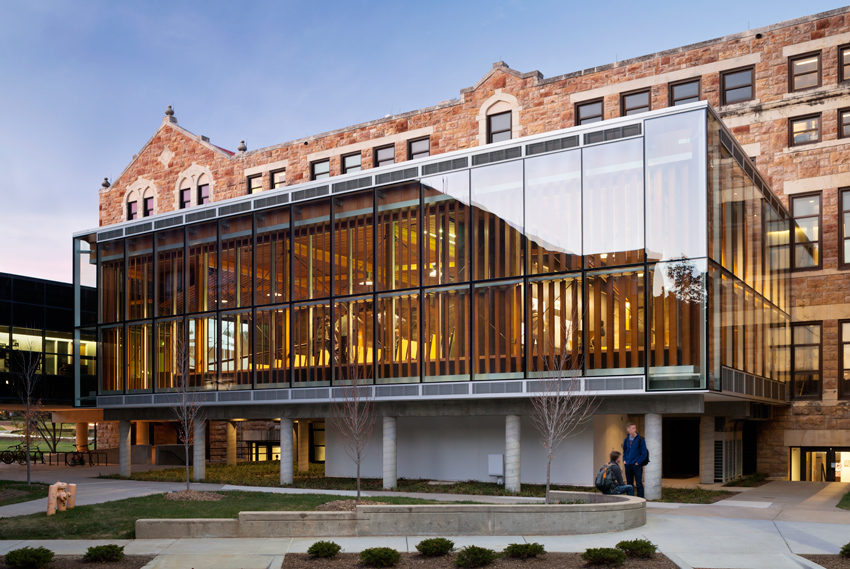
Photo courtesy of Transsolar
With a high level of user control and connection to the outdoors, thanks to a double facade designed by KPMB Architects, employee sick days at Winnipeg’s Manitoba Hydro Place were reduced by 1½ days per employee, per year.
In terms of the energy savings, post-occupancy measurements have shown that natural ventilation is being used about 40 percent of the time, which is noteworthy for Canada’s extreme climate, where average winter temperatures drops to -35 degrees Fahrenheit and summer temperatures exceed 100 degrees Fahrenheit, according to Raval.
“Similarly, the double facade of the Forum at the University of Kansas’ Marvin Hall has helped significantly reduce facade heat loss, extend the period of natural ventilation, drive natural ventilation by creating a stack effect inside the facade cavity, and provide acoustic protection,” he says.
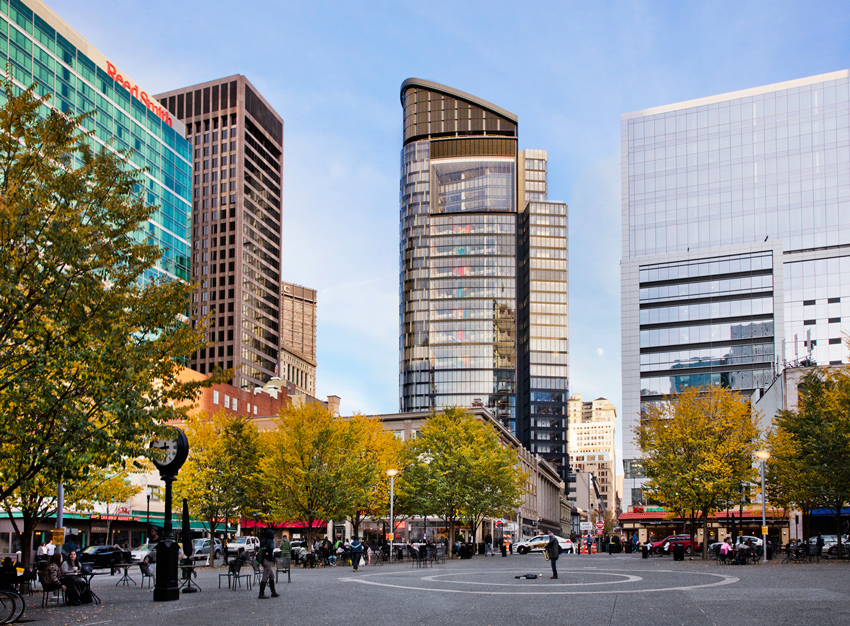
Photo courtesy of Transsolar
At University of Kansas’ Marvin Hall Forum, a double facade significantly reduces heat loss from the enclosure and promotes a high level of natural ventilation.
Patterson acknowledges that it is challenging to make economic sense of double-skin facade strategies in the current environment of what he calls lax building codes, greenwashing, and cost analysis driven by first-cost considerations. However, he anticipates that this will change at some point and performance issues will emerge as the drivers. “When this happens, double-skin strategies will be recognized as viable tools for the implementation of high-performance facade systems,” he predicts.
PNC PLAZA
Dubbed the greenest high-rise in the country, Pittsburgh’s new 33-story Tower at PNC Plaza is a great example of embracing highly energy-efficient technologies, while maintaining the visual glass aesthetic. Thanks, in part, to its double-skin facade, insulated glazing, solar chimney, and automated blinds, the tower is anticipated to use 50 percent less energy than ASHRAE 90.1-2007 requirements.
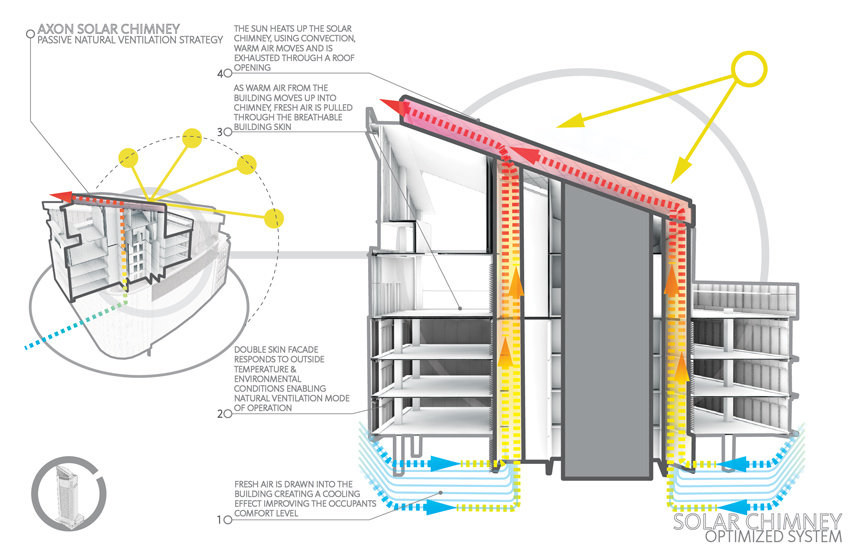
Photo courtesy of Connie Zhou Photography/Gensler
The double-skin facade, insulated glazing, solar chimney, and automated blinds at Pittsburgh’s 33-story PNC Plaza contribute to what is anticipated to be 50 percent less energy consumption than ASHRAE 90.1-2007 requirements for the building.
Offering part of the backstory as to how the designers identified the strategies to be incorporated in the project, Tranel remembers that the team was not in search of a particular technology to solve the energy-efficiency issue. Instead, they were more focused on architectural solutions. The process began with studying ventilation schemes, which revealed that the stack effect, as opposed to cross ventilation, was found to be more predictable and reliable.
“We then had to figure out how we would heat in the winter, cool in the summer, and ventilate in the spring and fall,” he explains. “Because ventilation was possible 42 percent of the time, and that 91 percent of the floor plate could have access to daylighting, when we put all that together, we saw that the facade was going to be the element that drives all this.”
“We added depth to the double facade to make it a nice user experience,” he continues, “and installed blinds in the cavity where motorized, automation systems are tied into weather-integrated data, which operate them up and down and control the tilt.”
By incorporating a triangular shaft on the building’s “attic,” the naturally heated air from the double-facade cavity rises up to the top of the solar chimney, while additional heat beats down from the roof, thereby creating free heating for the building. In the summer, the chimney pulls hot air from the facade cavity, via convention, where it is then released through the rooftop. “To us, that was the fundamental chassis of the project,” says Tranel.
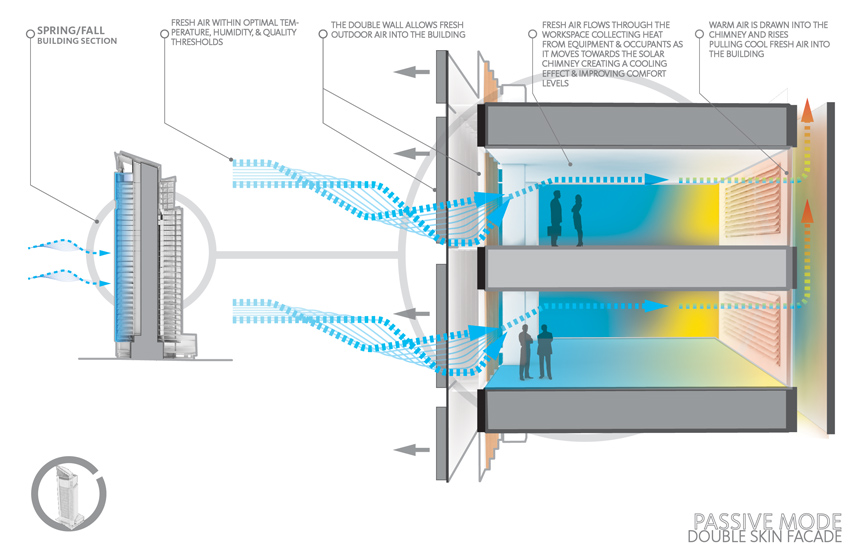
Image courtesy of Gensler
PNC Plaza’s solar chimney harvests free heating for the building in the winter and exhausts hot air from the facade cavity in the summer.
While the building uses a sophisticated building automation system (BAS) to operate the two facades based upon air quality, temperature, and humidity, the design team tried to keep things simple by installing the same motor for all of the blinds, in addition to building a mock-up to test all of the systems prior to construction.
The outer facade is made of aluminum and clear glass with no low-e glazing, as the blinds are able to take care of glare and solar gain issues, while preserving the clearest views to the city. The inner facade is made with insulating glass and glulam lumber inside a fully unitized curtain wall to create a warmer, hospitable aesthetic.
The outer facade windows opens to less than 4 inches, to meet the building safety code of 4 inches, and occupants can access the inner facade doors to enjoy the patio areas incorporated into the cavity.
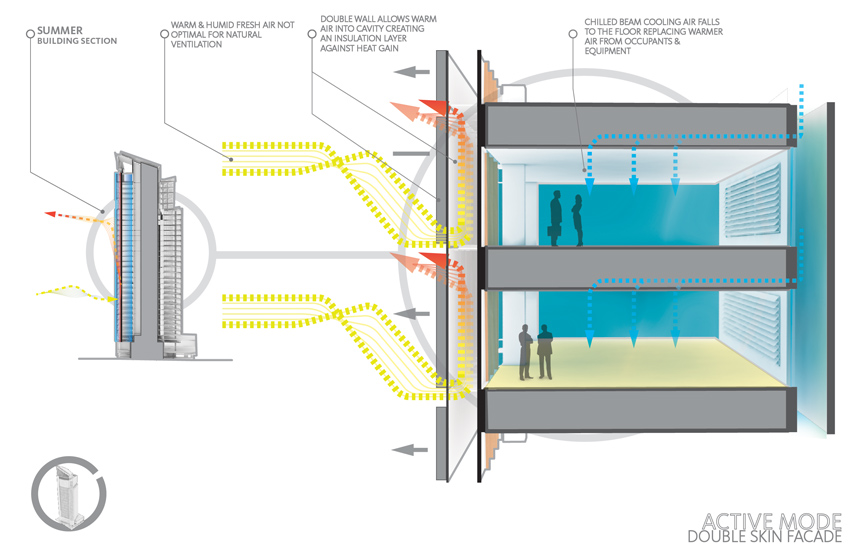
Image courtesy of Gensler
In passive mode, the double-facade windows are opened, drawing fresh air into the building and expelling hot air created by solar heat gain into the solar chimney. In active mode, the facade is closed and a chilled beam system is used for cooling.
The striking, high-profile project is certainly turning heads, but as compared to a typical building, such a highly sustainable effort required a very high degree of interdisciplinary collaboration to get there. Fortunately, having a clear client vision helped quite a bit, according to Tranel.
JEROME L. GREENE SCIENCE CENTER
Another unique application of double-skin facade technology can be found at Columbia University’s Jerome L. Greene Science Center in Manhattan—designed by Renzo Piano Building Workshop and SOM—where a total of six different wall types were incorporated into the 10-story Center in which mind, brain, and behavior research initiatives are taking place.
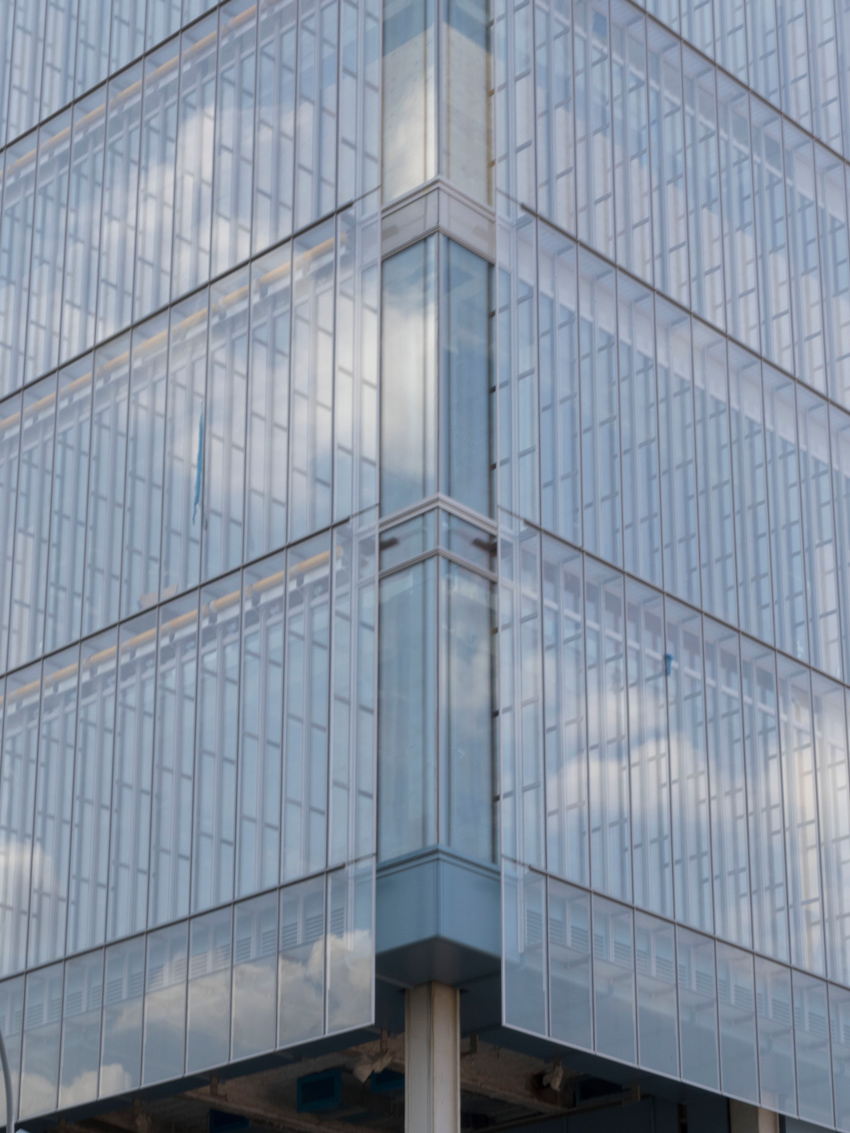
Photo courtesy of Enclos
Six different wall types were incorporated into Columbia University’s Jerome L. Greene Science Center in New York City, designed by Renzo Piano Building Workshop and SOM, including a double-wall facade.
Stretched across the 175,988 square feet of building envelope, primarily fashioned with transparent floor-to-ceiling glass, are double-skin walls, high-performance structural facades, metal and glass canopies, and vestibules. While daylighting certainly played a significant role, it was actually the surrounding urban acoustics—including a train line within 60 feet of the building—that primarily drove the facade design.
“The facades of the Science Center more or less diagram the various internal building and external—including climate—forces acting on them,” states Patterson, whose firm customized and installed the facade systems. “For example, acoustic performance was the driver for the use of a double-skin strategy based upon the close proximity of the rail line and mitigating sound transfer to the interior.”
The double-skin facade itself is blast resistant, encompassing a total of 41,822 square feet. The exterior skin is made from laminated glass and consists of two ¼-inch lites with a PVB interlayer and mullions limited to 2½-inch sightline. The cavity is a small 16 inches in width, with a cast stainless steel bracket separating the two skins, and operable panels installed in every third module to allow for cleaning and maintenance of the interior shades.
In terms of the other facade systems, the first wall type is a custom stick-built storefront with insulated laminated glass supported by an AESS steel strong-back framing system incorporating 11 canopies. Wall two is a highly transparent blast-resistant system made from double insulated glass units, and the third wall type is the previously mentioned blast-resistant double-skin facade.
The fourth facade system features triple-insulated glass units, the fifth system is made of steel sheet panel cladding with exposed structural steel support, and the wall type number six is an opaque notch wall.
“This is a highly customized, complex and innovative facade system involving a demanding client and an uncompromising architect, which were all good things,” reflects Patterson. “The successful implementation of such a project requires the early involvement of the facade contractor in the design process, necessitating some form of collaborative delivery process as a strategy to mitigate the risk that accompanies complexity and innovation.”
“Enormous resources were committed to the development of the facade systems from concept design through the completion of visual and performance mockups,” he continues. “Before the activities of procurement, fabrication, assembly, and installation, the mockups are critically important to the success of the project.”
Because the facade was designed with minimal sightline obstructions, the fabrication tolerances were extremely tight. In order to achieve this, Enclos carefully sourced the building materials that were then assembled into prefabricated units at an off-site facility and delivered to the project site on a just-in-time basis.
MANHATTAN DISTRICTS 1/2/5 GARAGE
Just over in downtown Manhattan, the Manhattan Districts 1/2/5 Garage is yet another proof that double walls can be a viable high-performance option.
Designed by Dattner Architects and WXY Architecture Urban Design, the double-skin facade wraps the curtain wall with perforated, metal fins for the 425,000-square-foot facility housing three garages for the New York City Department of Sanitation.
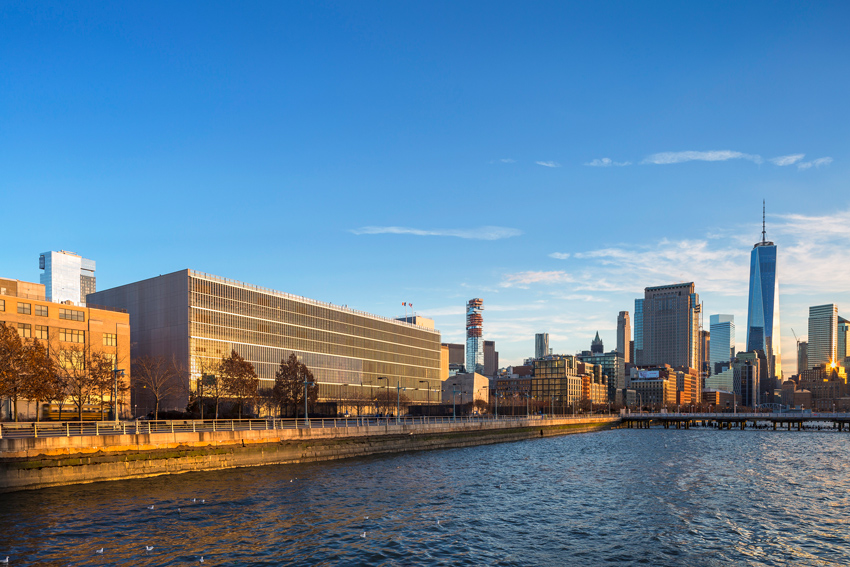
Photo courtesy of Dattner
Designed by Dattner Architects and WXY Architecture Urban Design, Manhattan Districts 1/2/5 Garage features a double-skin facade and perforated, metal fins.
The double-facade evolved as a comprehensive design solution to multiple driving forces, according to Gia Mainiero AIA, a senior associate of Dattner Architects in New York. One was the desire to bring abundant natural light into the facility without compromising on heat gain, and a second was concerns that vehicular activity within the building be shielded from the surrounding community.
In addition, the double facade was a way to break down the mass of the full-block building into smaller, rhythmic elements, with the goal of playing on light and perspective to create an ever-changing facade experience.
Tracking LEED Gold, and a benchmark project for New York City’s Active Design program, the south facade’s operable aluminum 30-inch fins continuously track the sun’s location, and the building management system sets them perpendicular to the sun’s azimuth to ensure optimal shading. Meanwhile, the solar fins on the west and east elevation are fixed.
“The facade design developed through a series of computer models and solar analyses, followed by detailed investigations of appropriate materials and the creation of full scale mockups,” explains Mainiero. “The size of the solar fins was studied carefully to ensure that they stood up to the 400-foot length of the building and maintained visual interest.”
Furthermore, the perforation pattern was studied extensively, including the percent of open area, perforation size, and spacing, through samples and mockups.
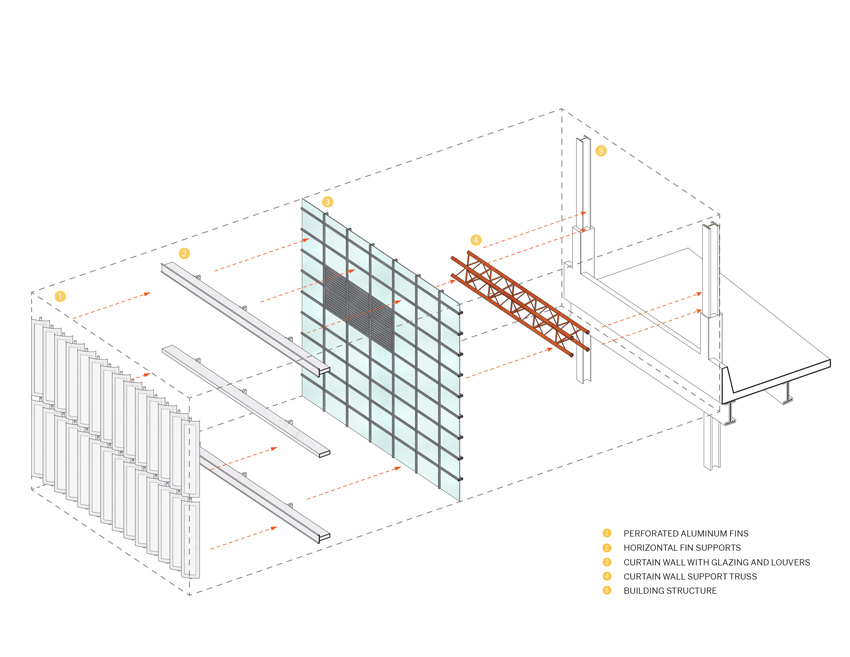
Image courtesy of Dattner
To optimize daylighting and mitigate solar heat gain, the Garage’s perforation pattern—including the percent of open area, perforation size, and spacing—was studied extensively.
“The right balance was found to allow views out, reduce overall weight, and maintain a robust appearance consistent with the building’s design,” she explains. “Also, glass reflectivity was minimized to prevent extensive reflections of the sunshades and more patterns from occurring.”
As was the case with the previously noted double-skin facades, a high level of coordination and integration was required to support the project. In particular, the dynamic loading of the heavy equipment and vehicles within the building created a situation where the slab deflections exceeded those allowable by standard curtain wall systems. To address this, the architect, structural engineer, and facade consultant worked closely together to develop inventive structural anchoring details for both vertical and horizontal load supports.
The final design implemented a series of box trusses spanning the columns, used for the sole purpose of facade support and isolated from the vibrations and deflections of the structural slab, according to Mainiero.
CRYSTAL BALL
Looking into their crystal balls, architects anticipate that facades will become more dynamic, eventually achieving a higher level of integration with the BAS system’s environmental, thermal, and lighting controls.
“Dynamic facades will be connected and synchronized with building technologies, enabling them to react and adapt to changing needs,” projects Paret. “This will result in building facades playing a significant role in net-zero energy and intelligent buildings that deliver well-balanced and optimized solutions for comfort, operations, economics, and energy efficiency.”
Similar to Gensler’s achievement with the PNC Tower, LPA’s D’Amato predicts that the future will bring much more of a relationship between internal use and spaces and the design of external facades. “It is about creating a balance between the user-driven function of the space and the performance of the facade,” he says.
As technology continues to advance, particularly in the realm of materials, architects also anticipate that glazing will achieve higher insulation levels and better protection from solar heat gain.
From a technical perspective, Mainiero expects that continued advancements in 3-D printing and computer-controlled CNC fabrication will enable curtain wall manufacturers who already offer standard solutions for shading to expand selections to allow customizable options, without a major retooling or alteration to the fabrication process.
In the grand scheme of things, Tranel points out that the industry is in the midst of seeing the entire energy sector being weaned from its dependence on fossil fuel energy. With unplugging from the electrical grid and achieving a carbon-neutral building as the ultimate long-term goal, high-performance facades will surely play a major role in this process.
END NOTES
1"High-Performance Flat Glass to 2017,” The Freedonia Group, June 2013. Web. 15 Mar. 2016.
2"The Commercial Glazing Markets 2015 Edition,” Palmer Market Research, Oct. 2015. Web. 15 Mar. 2016.
3"Low-Cost, High-Energy-Saving Dynamic Windows,” U.S. Department of Defense’s Environmental Security Technology Certification Program, Dec. 2014. Web. 15 Mar. 2016.
| The Ornamental Metal Institute of New York is a not-for-profit association created to advance the interests of the architectural, ornamental, and miscellaneous metal industries by helping architects, engineers, developers, and construction managers transform designs into reality. www.ominy.org | |
